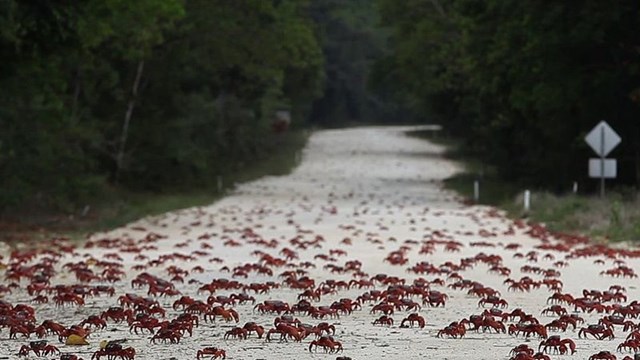Island of the Hungry Ghosts is one of those futzing docudrama hybrids that presents as at least two films in one, and one of these films is a good deal more engaging than the others. It is, on one hand, an Attenborough-like study of an island in the Indian Ocean, rich in lush green forestry and overrun by a staggering red crab population that moves more or less wherever it wants to go. (Some of them emerge from the undergrowth as terrifyingly huge: they make the lobster in Annie Hall look like a shy, retiring hermit crab.) On the other, the film is a speculative entry in the cinema of migration, for the island in question is Christmas Island, co-opted by the Australian government in recent years as a holding site for those refugees who've washed up on the country's shores. Already, you can spy the contrast writer-director Gabrielle Brady is working towards: creatures left alone (and, indeed, often encouraged) to roam freely versus creatures put under lock and key so that they can't. The problem is that the filmmaker takes a curious, circuitous route to arrive at that contrast, and she doesn't do all that much with it once she's there: you can get the gist of the film's thesis within twenty minutes, and are then left to watch what often feels like an arresting short that's been padded out to feature length.
Brady's way inside the holding camp is via Poh Lin Lee, a married mother-of-two who describes her role as a "torture and trauma counsellor", and specialises in a form of play therapy: in the becalmed confines of her office, she encourages detainees to place Playmobil-like figures (sharks, soldiers, gravestones) in a sandpit that represents their past, talk her through their choices, and thereby progress towards making some form of peace with what they've been through. These sessions can be revealing - one detainee suggests she could talk for days, and still not exhaust the bank of terrible things she's seen and undergone to get where she is today - but the camera seems more compelled by Lee herself: there are long scenes of the therapist, her French husband and adorable young daughters picnicking in the forest, or following up on banal tasks of admin when clients don't show up for one reason or another. These anecdotes work towards a generalised portrait of the privilege this woman enjoys in getting to drive home at the end of the day, but I think there's a touch of passive-aggression in the direction: Brady shows us a woman who's presumably profiting off an inhuman detention system, and never directly confronts her on the fact.
Well, perhaps this was never meant to be a barnstorming polemic as such, and the element of standoffishness makes sense if we understand that an individual like Lee is as close as Brady has been allowed to get to the dark heart of this facility. (The "no entry" signs we see as the therapist drives into work in the morning are there for a reason.) Yet Island's inquiry still feels circumscribed in some way, and you spot Brady turning to nature to fill the vacuum: shots of mobile patrol units clearing crabs from the road with brushes, or building crossing points for them with logs and branches. As a metaphor for the migrants we barely glimpse, these crabs are certainly vivid and scuttling - when the camera alights upon the flystrewn carcasses of unlucky crossers, those crabs who weren't looked out for or taken care of, the film underlines how sometimes even the hardest outer shell isn't enough - yet they're not enough in their own right to sustain Island of the Hungry Ghosts for 94 minutes. Individual sequences here are revealing and atmospheric, but it is on the whole, as that title maybe warned us, a very airy, scattily focused film about a very specific, very urgent situation.
Island of the Hungry Ghosts is now playing in selected cinemas, and streaming via MUBI.

No comments:
Post a Comment